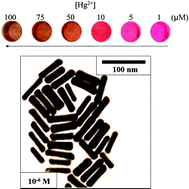Impacts that pH and metal ion concentration have on the synthesis of bimetallic and trimetallic nanorods from gold seeds†
Abstract
This paper describes the synthesis of Au–Ag bimetallic and Au–Ag–Hg trimetallic

* Corresponding authors
a
Department of Chemistry, National Taiwan University, Taipei, Taiwan
E-mail:
changht@ntu.edu.tw
Fax: 011 886 2 23621963
Tel: 011 886 2 23621963
This paper describes the synthesis of Au–Ag bimetallic and Au–Ag–Hg trimetallic

 Please wait while we load your content...
Something went wrong. Try again?
Please wait while we load your content...
Something went wrong. Try again?
Z. Yang, Y. Lin, W. Tseng and H. Chang, J. Mater. Chem., 2005, 15, 2450 DOI: 10.1039/B500256G
To request permission to reproduce material from this article, please go to the Copyright Clearance Center request page.
If you are an author contributing to an RSC publication, you do not need to request permission provided correct acknowledgement is given.
If you are the author of this article, you do not need to request permission to reproduce figures and diagrams provided correct acknowledgement is given. If you want to reproduce the whole article in a third-party publication (excluding your thesis/dissertation for which permission is not required) please go to the Copyright Clearance Center request page.
Read more about how to correctly acknowledge RSC content.
 Fetching data from CrossRef.
Fetching data from CrossRef.
This may take some time to load.
Loading related content
